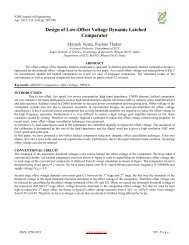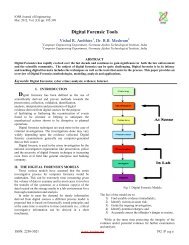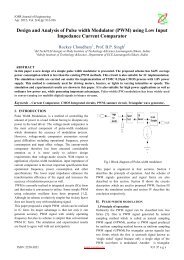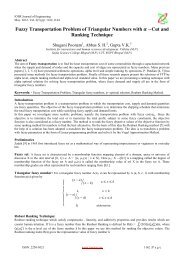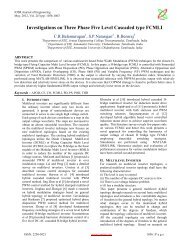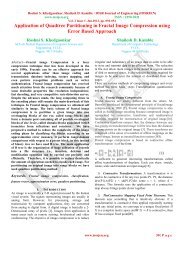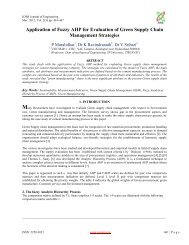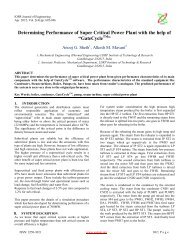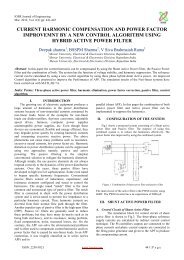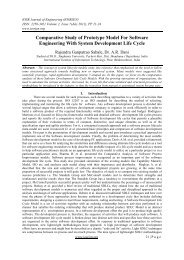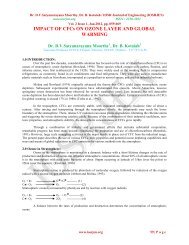Mix Design Procedure for Self Compacting Concrete - IOSRJEN
Mix Design Procedure for Self Compacting Concrete - IOSRJEN
Mix Design Procedure for Self Compacting Concrete - IOSRJEN
Create successful ePaper yourself
Turn your PDF publications into a flip-book with our unique Google optimized e-Paper software.
IOSR Journal of Engineering (<strong>IOSRJEN</strong>)e-ISSN: 2250-3021, p-ISSN: 2278-8719, www.iosrjen.orgVolume 2, Issue 9 (September 2012), PP 33-41<strong>Mix</strong> <strong>Design</strong> <strong>Procedure</strong> <strong>for</strong> <strong>Self</strong> <strong>Compacting</strong> <strong>Concrete</strong>1 Krishna Murthy.N, 2 Narasimha Rao A.V, 3 Ramana Reddy I .Vand 4 Vijaya sekharReddy.MEngineering Department , Yogi Vemana University, Kadapa, & Research Scholar of S.V.University ,Tirupati, IndiaProfessor ,Department of Civil Engineering, S.V. University, Tirupati, IndiaProfessor,Department of Civil Engineering, S.V. University, Tirupati, IndiaHOD,Department of Civil Engineering, SKIT, Srikalahasti, IndiaAbstract––<strong>Self</strong>-compacting concrete(SCC) possesses enhanced qualities and improves productivity and workingconditions due to elimination of compaction. SCC is suitable <strong>for</strong> placing in structures with congestedrein<strong>for</strong>cement without vibration and it helps in achieving higher quality of surface finishes. However utilization ofhigh reactive Metakaolin and Flyash as an admixtures as an effective pozzolan which causes great improvement inthe pore structure, also compactibility is affected by the characteristics of materials and the mix proportions, itbecomes necessary to evolve a procedure <strong>for</strong> mix design of SCC .In this paper presents an experimentalprocedure <strong>for</strong> the design of self-compacting concrete mixes. The relative proportions of key components areconsidered by volume rather than by mass. A simple tool has been designed <strong>for</strong> self compacting concrete (SCC)mix design with 29% of coarse aggregate, replacement of cement with Metakaolin and class F flyash,combinations of both and controlled SCC mix with 0.36 water/cementitious ratio(by weight) and 388 litre/m 3 ofcement paste volume. Crushed granite stones of size 16mm and 12.5mm are used with a blending 60:40 bypercentage weight of total coarse aggregate. Detailed steps are discussed in this study <strong>for</strong> the SCC and its mortar.Keywords–– <strong>Self</strong> compacting concrete, Metakaolin, Flyash, mixdesign, simple toolI. INTRODUCTION<strong>Self</strong>-compacting concrete (SCC) is an innovative concrete that does not require vibration <strong>for</strong> placing andcompaction. It is able to flow under its own weight, completely filling <strong>for</strong>mwork and achieving full compaction,even in the presence of congested rein<strong>for</strong>cement. The hardened concrete is dense, homogeneous and has the sameengineering properties and durability as traditional vibrated concrete.<strong>Concrete</strong> that requires little vibration or compaction has been used in Europe since the early 1970s butself-compacting concrete was not developed until the late 1980’s in Japan. In Europe it was probably first used incivil works <strong>for</strong> transportation networks in Sweden in the mid1990’s. The EC funded a multi-national, industry leadproject “SCC” 1997-2000 and since then SCC has found increasing use in all European countries. <strong>Self</strong>-compactingconcrete offers a rapid rate of concrete placement, with faster construction times and ease of flow aroundcongested rein<strong>for</strong>cement. The fluidity and segregation resistance of SCC ensures a high level of homogeneity,minimal concrete voids and uni<strong>for</strong>m concrete strength, providing the potential <strong>for</strong> a superior level of finish anddurability to the structure. SCC is often produced with low water-cement ratio providing the potential <strong>for</strong> highearly strength, earlier demoulding and faster use of elements and structures.The elimination of vibrating equipment improves the environment on and near construction and precastsites where concrete is being placed, reducing the exposure of workers to noise and vibration.The improved construction practice and per<strong>for</strong>mance, combined with the health and safety benefits make.SCC a very attractive solution <strong>for</strong> both precast concrete and civil engineering construction.In 2002 EFNARC published their “Specification & Guidelines <strong>for</strong> <strong>Self</strong>-<strong>Compacting</strong> concrete” which, atthat time, provided state of the art in<strong>for</strong>mation <strong>for</strong> producers and users. Since then, much additional technicalin<strong>for</strong>mation on SCC has been published but European design, product and construction standards do not yetspecifically refer to SCC and <strong>for</strong> site applications this has limited its wider acceptance, especially by specifiers andpurchasers. In 1994 five European organisations BIBM, CEMBUREAU, ERMCO, EFCA and EFNARC, alldedicated to the promotion of advanced materials and systems <strong>for</strong> the supply and use of concrete, createda “European Project Group” to review current best practice and produce a new document covering allaspects of SCC.www.iosrjen.org33 | P a g e
<strong>Mix</strong> <strong>Design</strong> <strong>Procedure</strong> <strong>for</strong> <strong>Self</strong> <strong>Compacting</strong> <strong>Concrete</strong>Power Plant (RTPP), Muddanur, A.P,India is used as additives according to ASTM C 618 [5]. As per IS-456(2000) [6], cement is replaced by weight of material. The specific gravity of Metakaolin is 2.5 and fly ash is2.12.2.2.4. COARSE AGGREGATECrushed granite stones of size 16mm and 12.5mm are used as coarse aggregate. As per IS: 2386 (PartIII)-1963 [6], the bulk specific gravity in oven dry condition and water absorption of the coarse aggregateare 2.66 and 0.3% respectively. The dry-rodded unit weight (DRUW) of the coarse aggregate with the coarseaggregate blending 60:40 (16mm and 12.5mm) as per IS: 2386 (Part III)1963 [4] is1608 kg/m 3 .2.2.5. FINE AGGREGATENatural river sand is used as fine aggregate. As per IS: 2386 (Part III)-1963 [6], the bulk specificgravity in oven dry condition and water absorption of the sand are 2.6 and 1% respectively.2.2.6. WATEROrdinary tapwater is usedIII.DESIGN OF SELF COMPACTING CONCRETE MIX DESIGN TOOL3.1. MATERIAL PROPERTIES FOR SCC MIX DESIGN TOOLThe following material properties <strong>for</strong> the SCC mix design tool are to be determined as shown in Table1.1. Specific gravity of cement, Metakaolin, fly ash, coarse aggregate and fine aggregate.2. Percentage of water absorption of coarse and fine aggregates.3. Percentage of moisture content in coarse and fine aggregates.4. Dry-rodded unit weight (DRUW) of coarse aggregate <strong>for</strong> the particular coarse aggregate blending.5. Percentage of dry material in SP cum retarder.www.iosrjen.org35 | P a g e
<strong>Mix</strong> <strong>Design</strong> <strong>Procedure</strong> <strong>for</strong> <strong>Self</strong> <strong>Compacting</strong> <strong>Concrete</strong>Table 4. CONCRETE MIX PROPORTIONS BY VOLUMECoarse aggregate (kg/cum) 771.84% of CA in concrete volume 29.01654<strong>Concrete</strong> <strong>Mix</strong> proprtions by volume (lit/cum)CA Mortar Sand Paste290.1654 709.8346 321.5551 388.2795Sand (kg/cum) 836.0431Total aggregates (kg/cum) 1607.8831Paste composition is shown in Table 5. Constituent materials <strong>for</strong> SCC are shown in Table 6.Constituent materials <strong>for</strong> SCM are shown in Table 7. This tool also displays the constituent materials <strong>for</strong> therequired volume of SCC or SCM as shown in Table 6 and Table 7. Aggregate proportions by volume and byweight are shown in Table 8.Table 5. PASTE COMPOSITIONVol. Water/Powder 1.119447Paste compositionkg/cumlit/cumCement MK WaterSP cumretarder VMA Paste506.35 26.65 191.88 4.797 0 388.083Table 6.CONSTITUENT MATERIALS FOR SCCConstituent Materials <strong>for</strong> <strong>Concrete</strong>MaterialRequired (cum)Initial Adjusted(kg/cum)0.0062g/mlCement 506.35 506.35 3.13937 3139.37Metakaolin 26.65 26.65 0.16523 165.23Water 191.88 199.6778 1.238002061 1238.002CA (16) 463.104 463.104 2.8712448 2871.245CA (12.50) 308.736 308.736 1.9141632 1914.163Sand (0.475) 836.0432 836.0432 5.183467691 5183.468SP (lit) 4.797 4.797 0.0297414 29.7414VMA (lit) 0 0 0 0Unit Weight 2337.56 Total (kg) 14.54121915 14541.22Constituent Materials <strong>for</strong> MortarMaterialRequired (cum)Initial Adjusted(kg/cum)0.0008g/mlCement 506.35 506.35 0.40508 405.08Metakaolin 26.65 26.65 0.02132 21.32Water 191.88 197.3622 0.157889785 157.8898Sand (0/4) 836.0432 836.0432 0.668834541 668.8345SP (lit) 4.797 4.797 0.0038376 3.8376VMA (lit) 0 0 0 0Unit Weight 1565.72 Total (kg) 1.256961926 1256.962www.iosrjen.org37 | P a g e
<strong>Mix</strong> <strong>Design</strong> <strong>Procedure</strong> <strong>for</strong> <strong>Self</strong> <strong>Compacting</strong> <strong>Concrete</strong>IV. CALCULATION OF KEY PROPORTIONSThe detailed steps <strong>for</strong> calculation of key proportions are presented below with an example. Theinterface of SCC mix design tool <strong>for</strong> the mix 29_60:40 is shown in Figure 1.SCC MIX SCENARIOA SCC mix with 29% coarse aggregate content of concrete volume with a paste volume of 388 litre/m 3have been designed <strong>for</strong> water/ binder ratio 0.36 (by weight). Cement has been replaced with 5%,10%,15% and20% of Metakaolin and 10%,20% and 30% of Class F fly ash and combinations of both Metakaolin and Flyash bypercentage weight of cementitious material. Coarse aggregate of sizes 16mm and 12.5mm with coarseaggregate blending 60:40 by percentage weight of total aggregate are used in this mix. High per<strong>for</strong>mancesuperplasticizer cum retarder are used. All the material properties and input parameters are shown in Table 1and Table 3. Air content assumed as 2% of concrete volume.4.1. CALCULATION OF COARSE AGGREGATE CONTENT IN CONCRETE VOLUMECoarse aggregate blending : 60:40Specific gravity of 16mm & 12.5mm : 2.66DRUW of coarse aggregate : 1608 kg/m 3% of Coarse aggregate in DRUW : 48Coarse aggregate weight : 1608*(48.00/100) = 771.84kg/m 3Coarse aggregate volume :[(771.84*(60/100))/2.66] +[(771.84*(40/100))/2.66]=290.01654135 litre/m 3 or 29.00%4.2. CALCULATION OF MORTAR VOLUMEMortar Volume : <strong>Concrete</strong> volume-coarse aggregate volume: 1000-290.0165 = 709.8346 litre/m 34.3. CALCULATION OF SAND VOLUME% of sand in Mortar volume : 45.30Sand Volume : 709.8346*(45.30/100) = 321.5551 litre/m 34.4. CALCULATION OF PASTE VOLUMEPaste Volume : Mortar volume-sand volume: 7098346-321.5551 = 388.2795 litre/m 34.5. CALCULATION OF PASTE COMPOSITIONSpecific gravity of cement : 3.15Specific gravity of Metakaolin : 2.50Air content : 2% = 20 litre/m 3Water/ binder ratio (by weight) : 0.36% of Metakaolin by weight of binder : 5% of SP by weight of binder : 0.9Binder : 533 kg/m 3Metakaolin : 533*(5/100) = 26.65 kg/m 3Cement : 533-26.65 = 506.65 kg/m 3Water : 533*0.36 = 191.88 litre/m 3Volume of cement : 506.35/3.15 = 160.746 litre/m 3Volume of Metakaolin : 26.65/2.50 = 26.65 litre/m 3SP : 533*(0.9/100) = 4.797 litre/m 3Total Paste volume : Volume of (cement+fly ash+Water+SP+ Air)(506.35/3.15)+(26.65/2.50)+191.88+4.797+2*10=388.0831 litre/m 3www.iosrjen.org38 | P a g e
<strong>Mix</strong> <strong>Design</strong> <strong>Procedure</strong> <strong>for</strong> <strong>Self</strong> <strong>Compacting</strong> <strong>Concrete</strong>In the tool, the binder has been adjusted to 533 kg/m 3 in order to obtain the required paste volume of about388.083 litre/m 3 (say 388 litre/m 3 ).4.6. CALCULATION OF CONSTITUENT MATERIALS FOR CONCRETESpecific gravity of sand : 2.6% of absorption of 20mm : 0.3% of absorption of 10mm : 0.3% of absorption of sand : 1.0% of moisture in 20mm : 0.0% of moisture in 10mm : 0.0% of moisture in sand : 0.0% of dry material in SP : 40Cement : 506.35 kg/m 3Metakaolin : 26.35 kg/m 3Initial water content : 191.88 litre/m 3Coarse aggregate : 771.84 kg/m 316mm coarse aggregate (CA1) : 771.84*(60/100) = 463.104 kg/m 312.5mm coarse aggregate (CA2) : 771.84*(40/100) = 308.736 kg/m 3Sand : 321.5551*2.6 = 836.043 kg/m 3Adjusted water content = Initial water - [CA1*(% of moisture - % of absorption)/100]- [CA2*(% of moisture - % of absorption)/100]- [sand*(% of moisture - % of absorption)/100]- [SP*(100-%of dry material in SP)/100]= 191.88 - [463.104 *(0-0.3)/100]-[ 291.67*(0-0.3)/100]- [836.043 *(0-1)/100]-[4.797*(100-40)/100]= 199.6778 litre/m 3Adjusted 16mm coarse aggregate : CA1*[1+(% of moisture/100)]463.104 *[1+(0/100)] = 463.104kg/m 3Adjusted 12.5mm coarse aggregate : CA2*[1+(% of moisture/100)]308.735*[1+(0/100)] = 308.735kg/m 3Adjusted sand : sand*[1+(% of moisture/100)]308.735*[1+(0/100)] = 308.735kg/m 34.7. CALCULATION OF CONSTITUENT MATERIALS FOR MORTARCoarse aggregate contribution should not be considered in the adjustment of water. The remainingconstituents are already discussed in the section 4.6.Initial water content : 191.88 litre/m 3Adjusted water content = Initial water - [sand*(% of moisture - % of absorption)/100]- [SP*(100-%of dry material in SP)/100]= 191.88 - [836.043 *(0-1)/100]-[4.797*(100-40)/100]= 197.36 litre/m 34.8. MIX PROPORTIONS<strong>Mix</strong> types with percentage relative proportions and mix proportions of constituent materials are shownin Table 9 and Table 10.www.iosrjen.org39 | P a g e
Coarse AggregateBlending<strong>Mix</strong> TypePercentage ByWeight(20 mm and 1029_60:40 a 6 mm)0<strong>Mix</strong> <strong>Design</strong> <strong>Procedure</strong> <strong>for</strong> <strong>Self</strong> <strong>Compacting</strong> <strong>Concrete</strong>Table 9. PERCENTAGE RELATIVE PROPORTIONS OF SCC MIXCementitious Material – OPC+5% Metakaolin w/cm – 0.36PercentagePercenPercentageof CoarsetageofaggregateofMortarPercentage ofPasteSaBy Volume ndin40 29.01654 70.98346 32.15551Mo38.8279rta529_60:40: where 28 is the percentage of coarse aggregate volume in a concrete mix60:40 is the coarse aggregate blending by percentage weight of 16mm and 12.5mm resp. rTable 10. MIX PROPORTIONS OF CONSTITUENT MATERIALSBinder Cement Metakaolin Water 16mm 12.5mm Sand SP<strong>Mix</strong> Typekg/m 3 Kg/m 3 Kg/m 3 l/m 3 Kg/m 3 kg/m 3 kg/m 3 l/m 329_60:40 533 506.35 26.35 191.88 463.104 308.736 836.0432 4.797<strong>Design</strong>ationSl. of <strong>Mix</strong>No. ProportionTable 11. MIX DESIGN PROPORTIONS FOR DIFFERENT COMBINATIONSTotalBinder(Kg/m 3 )Cement Metakao Flyash F.A C.A Water(Kg/m 3 )lin(Kg/m 3 (Kg/m 3 ) (Kg/m 3 ) (Kg/m 3 ) (Kg/m 3 ))S.P.(%)S.P(Kg/m 3 )W/Pratio1 MK5 533.00 506.35 26.65 ----- 836 771.84 191.88 0.9 4.797 0.362 MK10 530.00 477.00 53.00 ----- 836 771.84 190.80 0.9 4.770 0.363 MK15 527.00 447.95 79.05 ----- 836 771.84 189.72 0.9 4.743 0.364 MK20 523.50 418.80 105.00 ----- 836 771.84 188.46 0.9 4.712 0.365 FA10 524.50 472.00 ----- 52.45 836 771.84 188.82 0.9 4.721 0.366 FA20 513.50 410.80 ----- 102.70 836 771.84 184.86 0.9 4.622 0.367 FA30 502.00 351.75 ----- 150.75 836 771.84 180.90 0.9 4.523 0.368 MK5+FA30 499.50 324.68 25.00 149.85 836 771.84 179.82 0.9 4.500 0.369 MK10+FA20 507.50 355.25 50.75 101.50 836 771.84 182.70 0.9 4.570 0.3610 MK15+FA10 504.00 378.00 75.60 50.40 836 771.84 181.44 0.9 4.536 0.3611 SCC 536.00 536.00 ----- ----- 836 771.84 192.96 0.9 4.824 0.36V. CONCLUSIONSThe following conclusions can be drawn on the basis of SCC mix design tool <strong>Self</strong>-<strong>Compacting</strong> <strong>Concrete</strong> isconsidered to be the most promising building material <strong>for</strong> the expected revolutionary changes on the job site aswell as on the desk of designers and civil engineers.<strong>Self</strong> compacting concrete mix design tool is developed based on the key proportions of theconstituents. This tool is very simple and user friendly <strong>for</strong> the self compacting concrete mix design. It can beused <strong>for</strong> the SCC mix with or without blended cement and coarse aggregate with or without coarse aggregateblending. This tool can also be enhanced <strong>for</strong> multi blended cements with more additives and also useful <strong>for</strong> <strong>Self</strong>compacting mortar design. It displays all necessary data <strong>for</strong> SCC mix design and also displays constituentmaterials <strong>for</strong> SCC or SCM <strong>for</strong> the required volume.www.iosrjen.org40 | P a g e
<strong>Mix</strong> <strong>Design</strong> <strong>Procedure</strong> <strong>for</strong> <strong>Self</strong> <strong>Compacting</strong> <strong>Concrete</strong>REFERENCES[1] IS: 3812-2003, Specifications <strong>for</strong> Pulverized fuel ash, Bureau of Indian Standards, New Delhi, India.[2] IS: 8112-1989, Specifications <strong>for</strong> 43 grade Portland cement, Bureau of Indian Standards, New Delhi, India.[3] IS: 383-1970, Specifications <strong>for</strong> Coarse and Fine aggregates from Natural sources <strong>for</strong> <strong>Concrete</strong>, Bureau of IndianStandards, New Delhi, India.[4] American <strong>Concrete</strong> Institute. “<strong>Self</strong>-Consolidating <strong>Concrete</strong>”, ACI 237R-07.[5] American Society <strong>for</strong> Testing and Materials. “Standard specification <strong>for</strong> coal fly ash and raw or calcined naturalpozzolan <strong>for</strong> use in concrete”, ASTM C 618 (2003).[6] Bureau of Indian Standards. “Plain and rein<strong>for</strong>ced concrete code <strong>for</strong> practice”, IS-456 (2000), New Delhi.[4] Bureau of Indian Standards. “Methods of test <strong>for</strong> aggregates <strong>for</strong> concrete. Specific gravity, Density, Voids,Absorption and Bulking”, IS-2386 (Part III, 1963).[7] Domone PLJ. 2006b. “<strong>Self</strong>-compacting concrete: An analysis of 11 years of case studies”. Cement and <strong>Concrete</strong>Composites 28(2):197-208.[8] EFNARC (European Federation of national trade associations representing producers and applicators of specialistbuilding products), Specification and Guidelines <strong>for</strong> self- compacting concrete, February 2002, Hampshire, U.K.[9] EFNARC. “Specification and guidelines <strong>for</strong> self-compacting concrete. European Federation of Producers andApplicators of Specialist Products <strong>for</strong> Structures”, 2002.[10] RILEM TC 174 SCC. “<strong>Self</strong> compacting concrete State-of-the-art report of RILEM technical committee 174-SCC”.Skarendahl A, Petersson O, editors, RILEM Publications S.A.R.L., France, 2000.[11] Ghazi F Kheder, Rand S Al Jaidiri. 2010. “New Method <strong>for</strong> Proportioning <strong>Self</strong>-Consolidating <strong>Concrete</strong> BasedonCompressive Strength Requirements”. ACI Materials 107(5):490-497.[12] Goodier C. 2001. “<strong>Self</strong>-<strong>Compacting</strong> <strong>Concrete</strong>”. European Network of Building Research Institutes (ENBRI).17:6[13] Khayat KH. 1998. Viscosity-enhancing admixtures <strong>for</strong> cement-based materials - An overview. Cement and <strong>Concrete</strong>Composites, No.20, 2-3: 171-188.[14] Newman J, Choo BS. Advanced concrete technology concrete properties. Elsevier Butterworth Heinemann,2003.[15] Okamura H, Ozawa K. 1995. “<strong>Mix</strong> design <strong>for</strong> self-compacting concrete”. <strong>Concrete</strong> Library of Japanese Society ofCivil Engineers 25(6):107-120.[16] Okamura H, Ouchi M. 1999. “<strong>Self</strong>-compacting concrete development, present use and future”. In: The 1stInternational RILEM Symposium on <strong>Self</strong>-<strong>Compacting</strong> <strong>Concrete</strong>. Skarendahl A, Petersson O, editors, RILEMPublications. S.A.R.L, France. 3-14.[17] Ozawa K, Maekawa K, Kunishima M, Okamura H. 1989. “Development of high per<strong>for</strong>mance concrete based on thedurability design of concrete structures”. 445-450.[18] Nagamoto N., Ozawa K., <strong>Mix</strong>ture properties of <strong>Self</strong>-<strong>Compacting</strong>, High-Per<strong>for</strong>mance <strong>Concrete</strong>, Proceedings,Third CANMET/ACI International Conferences on <strong>Design</strong> and Materials and Recent Advances in <strong>Concrete</strong>Technology, SP- 172, V. M. Malhotra, American <strong>Concrete</strong> Institute, Farmington Hills, Mich. 1997, p. 623-637.[19] Khayat K.H., Ghezal A., Utility of Statistical models in Proportioning <strong>Self</strong>-<strong>Compacting</strong> <strong>Concrete</strong>, Proceedings,RILEM[20] International symposium on <strong>Self</strong>-<strong>Compacting</strong> <strong>Concrete</strong>, Stockholm, 1999, p. 345-359.[21] Okamura H., Ozawa K., <strong>Mix</strong> <strong>Design</strong> <strong>for</strong> <strong>Self</strong>-<strong>Compacting</strong> <strong>Concrete</strong>, <strong>Concrete</strong> Library of Japanese Society of CivilEngineers, June 25, 1995, p. 107-120.[22] Nagataki S., Fujiwara H., <strong>Self</strong>-<strong>Compacting</strong> property of Highly-Flowable concrete, Second Conference on advances in<strong>Concrete</strong> Technology, ACI SP-154,V.M. Malhotra, American <strong>Concrete</strong> Institute, June 1995, p. 301-304.[22] Khayat K.H., Manai K., Lesbetons autonivlants : proprietes, charcterisation et applications , colloque surles betons autonivlants, Universite de Sherbroke, Canada, November 1996, p. 8.[23] Petersson O., Billberg P., Van B.K., A model <strong>for</strong> <strong>Self</strong>-<strong>Compacting</strong> <strong>Concrete</strong>, Proceedings of Production Methods andWorkability of <strong>Concrete</strong>,1996, E & FN Span, London, p. 483- 492.www.iosrjen.org41 | P a g e



